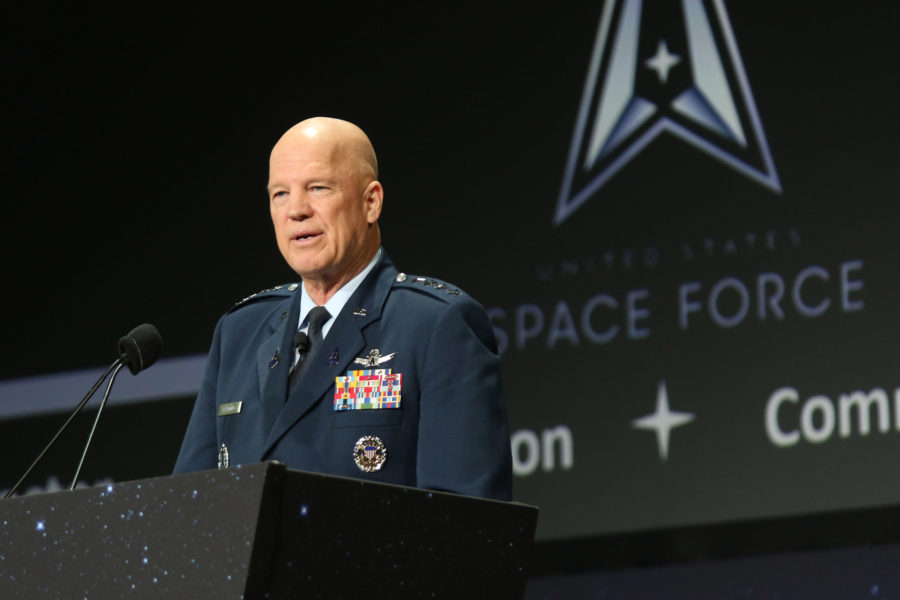The U.S. military can’t afford the new proliferated, multi-orbit satellite constellations it needs unless military contractors cut costs by an order of magnitude, the Space Force Chief said.
“We must also slash costs,” Gen. John W. “Jay” Raymond, Space Force Chief of Space Operations, told the 37th annual Space Symposium in Colorado Springs, Colo., April 5. “The government cannot afford a distributed resilient force design, unless industry makes this change with us,” he added. Addressing industry directly, he told them, “We need you to deliver. We need you to deliver at cost points of double digit millions rather than triple digit [millions] or billions.”
“If we’re going to migrate away from large monolithic system systems to hybrid diversified space architectures, we cannot continue to build expensive satellites with exquisite mission assurance. We need to focus on reduction of costs as a key driver,” he said. The Space Warfighting Analysis Center, as part of its work designing a new space architecture for the Space Force, is “identifying specific cost targets and the trade offs” needed to reach them in future constellations, he added.
The shift from space architectures based on a handful of extremely expensive satellites, to ones using constellations of dozens, hundreds, or even thousands of smaller, less costly satellites, typically in lower orbits, is the cornerstone of Raymond’s plan to make U.S. space capabilities better able to survive a shooting war in orbit, a quality the military calls resilience.
“The transformation to a more resilient architecture is the centerpiece of our budget submission in the Fiscal Year 2023 budget request” just issued by the President, said Raymond.
“Resilience is important because it denies the adversary first mover advantage, the benefit of a sudden decisive attack in space,” Raymond said. By allowing the U.S. military to ride out a sneak attack in orbit, resilience bolsters deterrence and thereby helps keep the peace, he added.
“Our primary purpose is to deter war,” Raymond said. “We do that by showing strength, by showing that we would win. In peacetime we must be visibly present in orbit just as we are on land, on the sea, and in the air, to show that the rules-based order that we have upheld since WWII applies everywhere, including space.”
Part of ensuring that superiority is maintaining the U.S. military’s technological edge, which many believe to be eroding, especially over advancing near-peer adversaries like China.
“To maintain our enduring advantage, we need that fluency throughout our ranks to solve problems quickly,” Raymond said, “So we’re working to develop an organic coding capability from the ground up.”
He highlighted the “Supra Coders,” a program launched last year that provides advanced software coding training for Guardians in Space Operations Command deltas, Space Force’s tactical-level units. “Unless you’re an astronaut, you experience space through data, lots and lots of data.” And handling that data requires software.
The idea of Supra Coders, Raymond explained, is to give Deltas a native coding capability, so they can fix software issues quickly without having to wait for specialist assistance or contractors to show up. The program, which is funded for 60 students this year, will grow to 90 in fiscal 2023, Raymond said.
The need to maintain superiority in space also was a central theme in Air Force Secretary Frank Kendall’s symposium keynote.
Because space-based capabilities like GPS and satellite communications ensured U.S. military advantage in other domains, Kendall explained, “Space is a great enabler and essential for all other military operations.”
“We are not yet at a time where control of space alone implies military control of the planet. That is still science fiction. But we are at a point where control of space is essential, if one has to control the air, the sea, or the land,” Kendall said. He added that America would share that control with its allies and partners, increasing numbers of which, most recently the Australians, had set up their own Space Commands, facilitating cooperation with United States.
Kendall urged U.S. allies to “Continue to build out your military space enterprises so we can work together and benefit from your perspectives, competencies, and shared investments.”
Even U.S. allies with limited space capabilities could join, he pledged. “Nations that do not intend to build out the full array of space systems can still meaningfully contribute to the transformational architectures that the Space Force is building, and benefit from the services and products that we all can provide together,” he said.
That partnership theme was echoed in the third keynote, from Principal Deputy Director of National Intelligence Stacey A. Dixon. Over the 37 years the Space Symposium has met, Dixon observed, “the nature of space exploration and exploitation, and what space means to our nation, to our national security, and to humankind, all of that has changed,” she said. The space domain, “once the exclusive purview of governments, is now open to all.”
“It is no longer one small step,” she said, “It’s not even just one giant leap, it is the promise of a transformed world.” But she warned that there were “many different visions” competing to shape that future.
In the contest to determine the future of space, the world’s democracies had one “extraordinary advantage” over authoritarian adversaries like Russia and China, Dixon said. “Our underlying system of free, open, and competitive markets and businesses, working together with government, academic institutions, and others outside of government, along with the vital role of the free press.” This “constellation of independent and incredibly innovative parties, partnerships, and the values that sustain them, is something autocracies cannot match,” she concluded.
